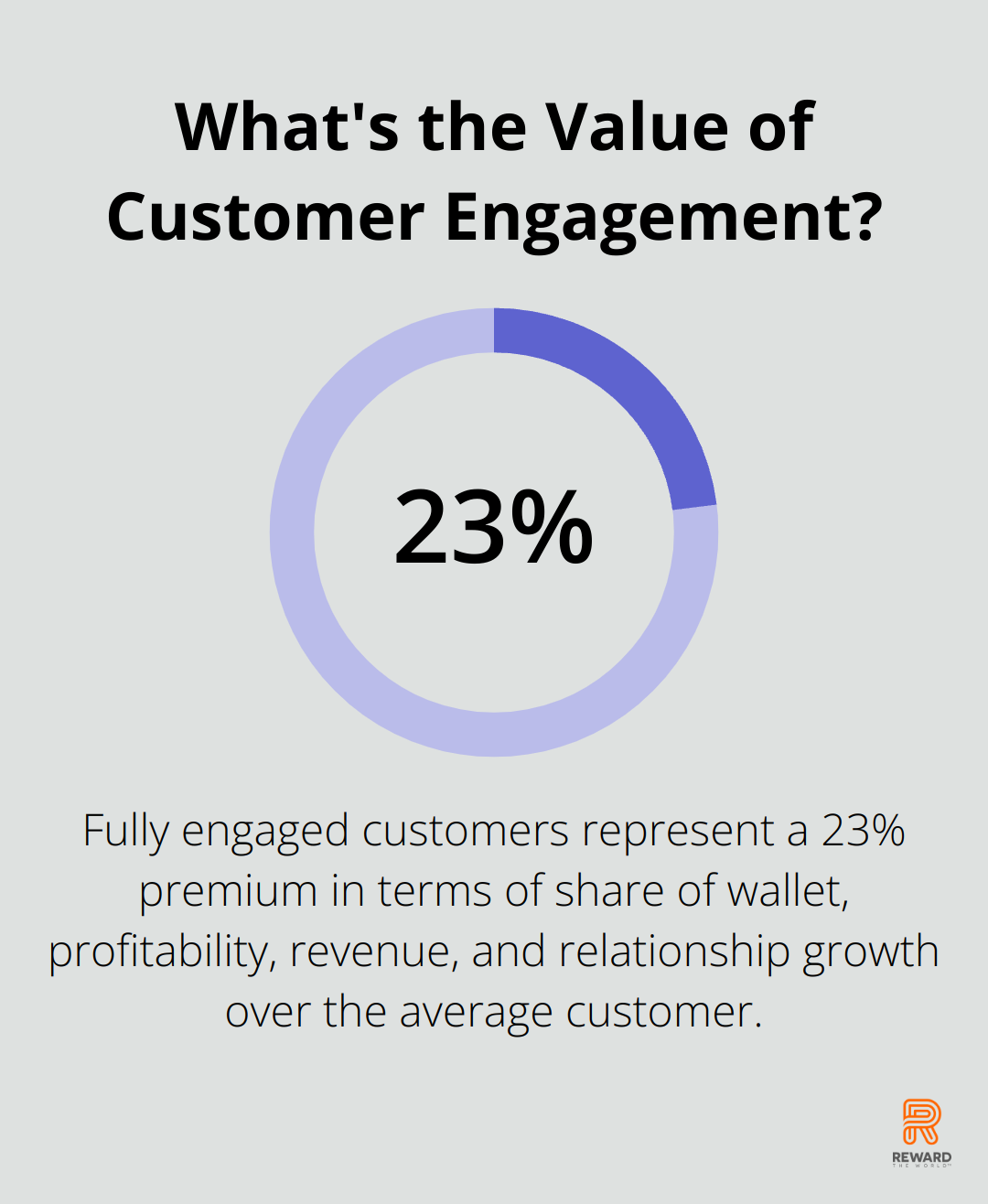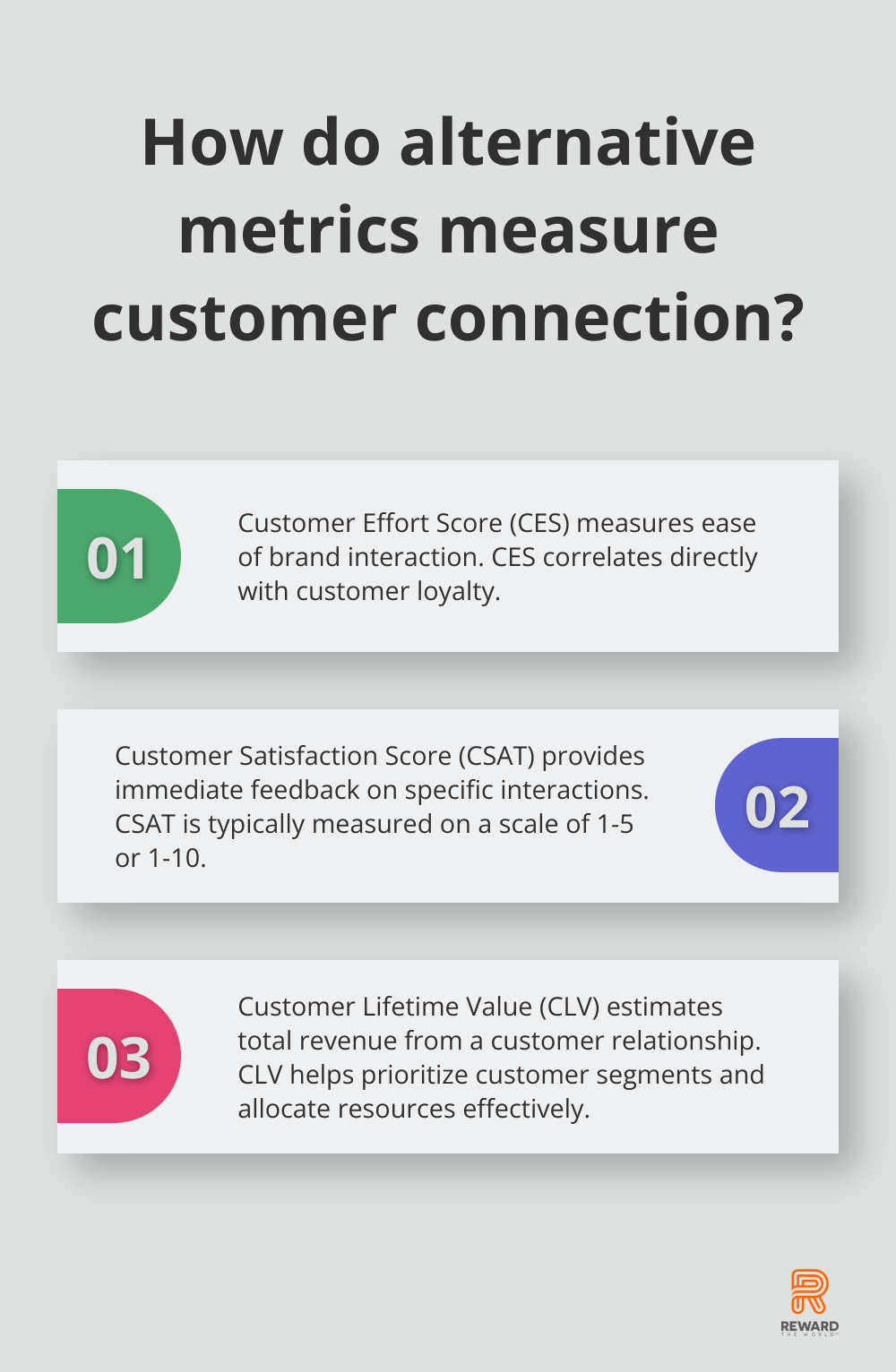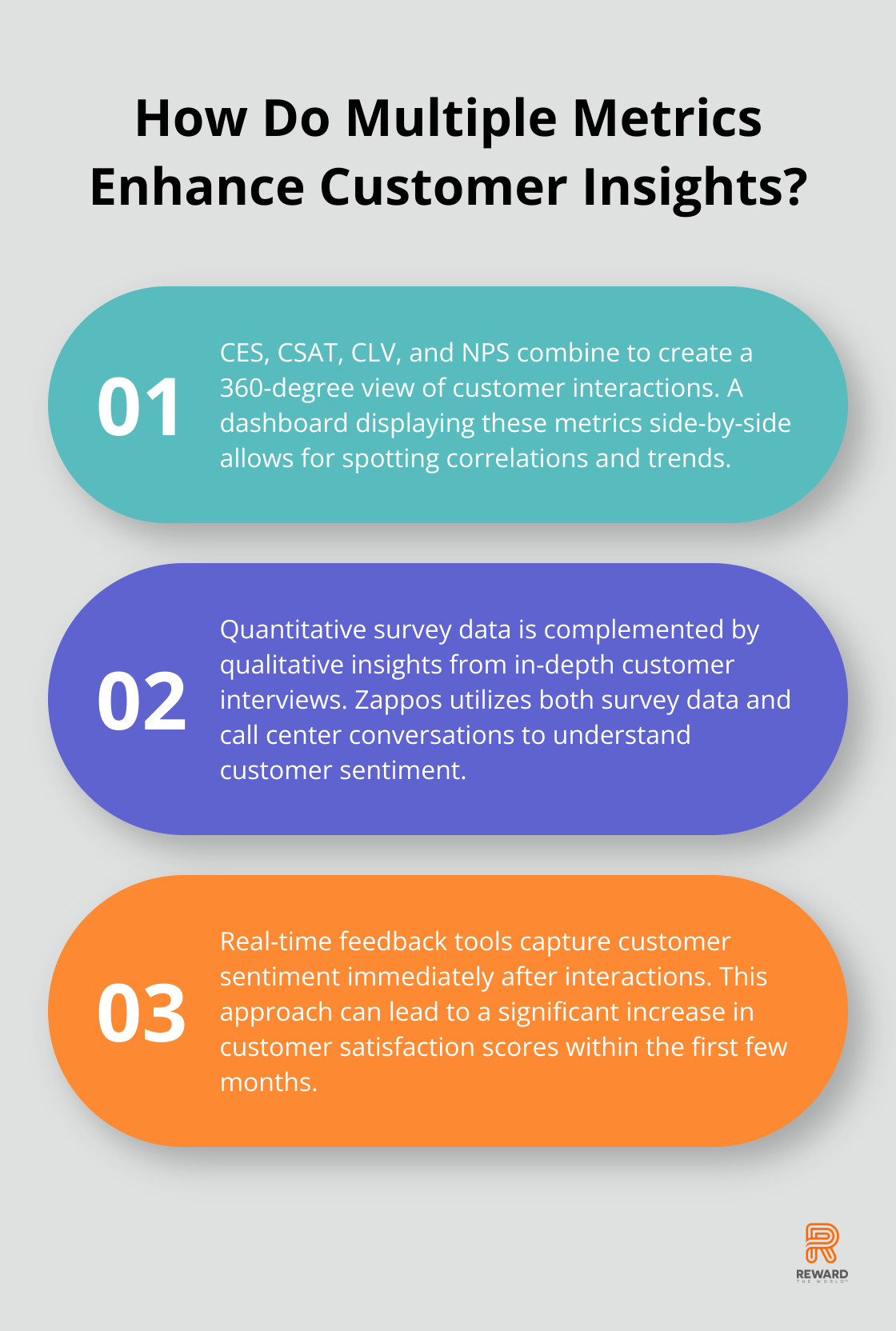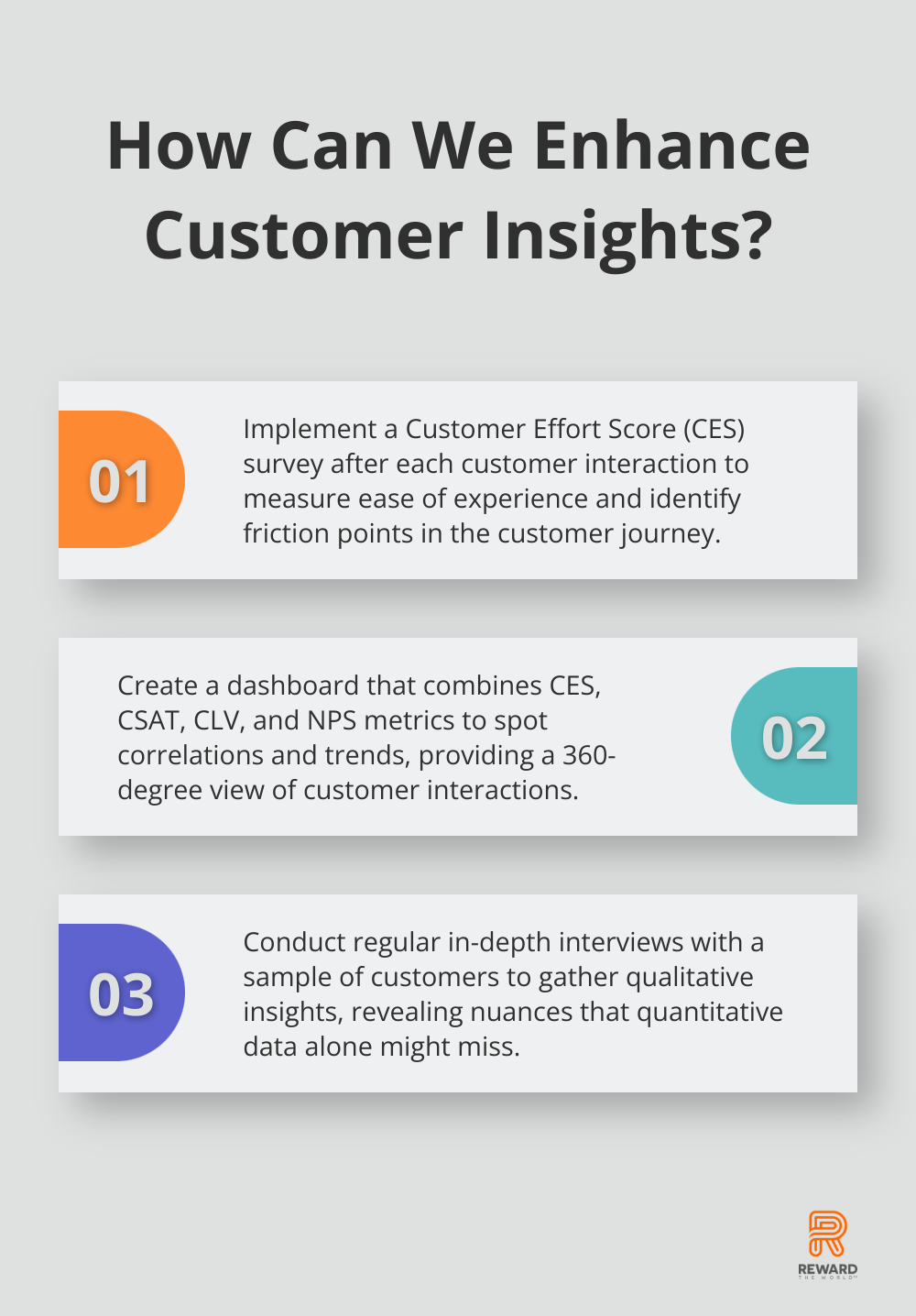
At Reward the World, we’ve seen firsthand how traditional metrics like NPS fall short in capturing true customer connection. It’s time to explore more comprehensive emotional loyalty metrics that paint a fuller picture of customer relationships.
In this post, we’ll dive into alternative measures that go beyond surface-level satisfaction to gauge genuine customer sentiment and loyalty. We’ll also share practical strategies for implementing these metrics to drive business growth and foster lasting customer bonds.
What Drives True Customer Connection?
The Limitations of NPS
Net Promoter Score (NPS) has been a staple metric for years, but it only scratches the surface. While NPS can provide some insights, it doesn’t always capture the full picture of customer loyalty and retention.
Emotional Connection: The Missing Link
Research from Motista highlights that emotionally connected customers have a 306% higher lifetime value (5.1 years) than satisfied customers (3.4 years). These customers purchase more, visit more frequently, and show less price sensitivity. The question remains: how do we measure this emotional connection?
Actionable Metrics for Deeper Insights
Success comes from combining multiple data points:
- Purchase Frequency: The rate at which customers buy from you
- Interaction Quality: Sentiment analysis of customer service interactions
- Brand Engagement: Social media interactions and user-generated content
- Feedback Implementation: The speed at which customer suggestions become actions

Tracking these metrics paints a more comprehensive picture of customer connection.
The Bottom Line Impact
Strong customer connections directly impact the bottom line. A Gallup study found that fully engaged customers represent a 23% premium in terms of share of wallet, profitability, revenue, and relationship growth over the average customer.
Moving Beyond Simple Scores
To truly understand and nurture customer connections, businesses must look beyond simple scores. (Focusing on emotional engagement and using a variety of metrics can build lasting relationships that drive sustainable growth.)
As we explore alternative measures in the next section, we’ll uncover how to implement these insights effectively and create a more holistic view of customer relationships.
How to Measure True Customer Connection Beyond NPS
At Reward the World, we understand that relying on a single metric like NPS doesn’t capture the full spectrum of customer relationships. Let’s explore some powerful alternatives that provide a more comprehensive view of customer connection.
Customer Effort Score (CES)
Customer Effort Score measures how easy it is for customers to interact with your brand. This metric directly correlates with customer loyalty. It’s a type of customer survey that assesses the ease of a client’s interaction with your business.

To implement CES, ask customers to rate the ease of their experience after each interaction. Try to reduce friction points in the customer journey to improve this score.
Customer Satisfaction Score (CSAT)
CSAT provides immediate feedback on specific interactions or touchpoints. It’s typically measured on a scale of 1-5 or 1-10 and asks customers how satisfied they were with a particular experience.
While CSAT excels at pinpointing areas for improvement, it’s important to note that satisfaction doesn’t always equate to loyalty. Use CSAT in conjunction with other metrics for a more holistic view.
Customer Lifetime Value (CLV)
Customer Lifetime Value estimates the total revenue a customer will generate over their entire relationship with your company. This metric helps prioritize customer segments and allocate resources more effectively.
When measuring CLV, it’s best to look at the total average revenue generated by a customer and the total average profit. Each provides important insights into customer value.
Emotional Connection Score (ECS)
ECS measures the emotional bond between customers and your brand. This metric is particularly powerful because emotionally connected customers can be more valuable.
To measure ECS, use surveys that assess how strongly customers agree with statements like “This brand gets me” or “I feel an emotional connection to this brand.” Combine these results with behavioral data to get a more accurate picture.
The integration of these metrics into your customer analysis will yield deeper insights into what truly drives loyalty and connection. The next section will explore how to implement a comprehensive customer connection strategy that leverages these metrics effectively.
How to Build a Holistic Customer Connection Strategy
Integrate Multiple Metrics for Deeper Insights
Combine CES, CSAT, CLV, and Net Promoter Score (NPS) to create a 360-degree view of customer interactions. CSAT measures customer satisfaction with regards to a product or service, whereas NPS is best used to measure the overall relationship the customer has with an organization.

Create a dashboard that displays all these metrics side by side. This allows you to spot correlations and trends that might be missed when looking at each metric in isolation.
Use Both Quantitative and Qualitative Data
Quantitative data from surveys is important, but qualitative insights are equally valuable. Conduct regular in-depth interviews with a sample of your customers. These conversations can reveal nuances that numbers alone might miss.
Zappos uses both survey data and call center conversations to understand customer sentiment.
Use Technology for Real-Time Insights
In today’s fast-paced business environment, waiting weeks or months for customer feedback isn’t viable. Implement real-time feedback tools that allow you to capture customer sentiment immediately after an interaction.
Real-time feedback capabilities allow businesses to address issues promptly and capitalize on positive experiences. This approach can help achieve a significant increase in customer satisfaction scores within the first few months of implementation.
Empower Your Team to Foster Genuine Connections
Your employees are the front line of customer connection. Invest in training programs that focus on emotional intelligence and active listening skills. These findings underscore the pivotal role of emotional intelligence in enhancing customer retention, aligning with previous research suggesting that companies prioritizing this type of training see an increase in customer retention rates.
Create a culture where employees can go above and beyond for customers. Ritz-Carlton’s policy of allowing employees to spend up to $2,000 to solve any customer problem without needing approval is a prime example of this approach in action.
Refine Your Strategy Continuously
Customer preferences and behaviors evolve, and so should your strategy. Review and adjust your approach based on the insights you gather. Set up quarterly review sessions where you analyze trends, identify areas for improvement, and brainstorm new ways to enhance customer connections.
Final Thoughts
Net Promoter Score alone fails to capture the depth of customer relationships in today’s complex business landscape. Companies must adopt a multi-faceted approach that incorporates emotional loyalty metrics and diverse data points to truly understand and nurture customer loyalty. The combination of Customer Effort Score, Customer Satisfaction Score, Customer Lifetime Value, and Emotional Connection Score provides a holistic view of customer relationships.

Emotionally connected customers demonstrate higher lifetime value, increased purchase frequency, and greater brand advocacy. These deeper connections foster lasting relationships that drive sustainable growth and competitive advantage. Companies that focus on emotional connections will unlock deeper insights, drive meaningful engagement, and build stronger, more profitable customer relationships.
Reward the World’s global incentives platform helps businesses foster loyalty, increase conversions, and enhance employee recognition through instant rewards. Our platform’s analytics and integration capabilities enable companies to gain valuable insights into customer behavior and preferences (creating more targeted and effective loyalty strategies).
